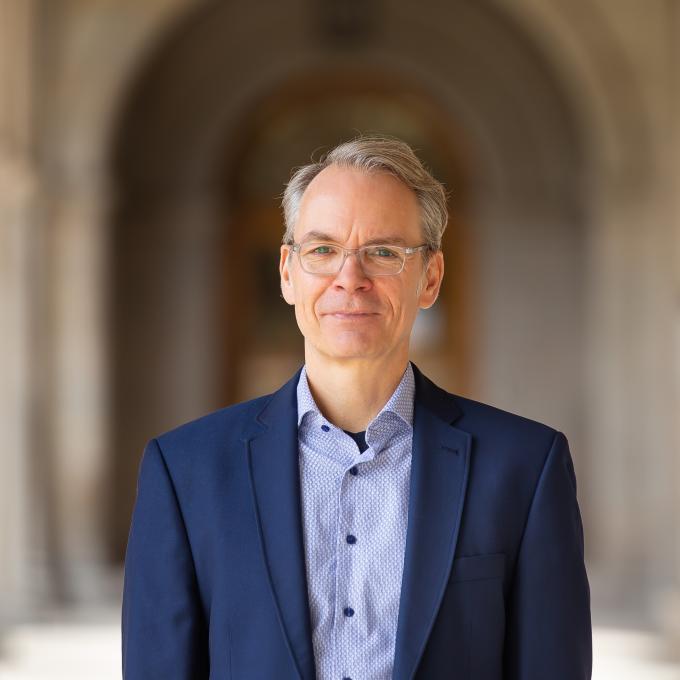Wolfram Schmidgen’s new book uncovers the literary uses of — and anxiety around — the idea of a disordered world.

In a new book, Wolfram Schmidgen, professor of English, explains how the excitement and anxiety about a disordered world affected literary invention in 18th-century England. Infinite Variety: Literary Invention, Theology, and the Disorder of Kinds, 1688-1730 (University of Pennsylvania Press) combines intellectual history with close analysis of the literary inventions of Richard Blackmore, John Locke, Jonathan Swift, and Daniel Defoe.
Prior to the 17th century, theologians and philosophers long believed in an orderly world, created according to the ideals of a higher power. Disorder was feared. By the late 1600s, Schmidgen argues, philosophers began to realize that disorder may be more fundamental than order. Political revolutions and the rapid emergence of religious sects made many thinkers and artists believe that disorder is the basic condition of human life.
As frightening as this new reality appeared, it also opened up opportunities that many writers were keen to exploit. As social upheaval increased, scientists and philosophers began to observe a disorder of a more natural kind, as well. Thinkers like John Locke and John Ray were increasingly less sure that there is a natural order of species that they could describe through observation.
“The poet Richard Blackmore developed an aesthetic practice that is based on the idea that the order of kinds in the natural world is in fact an arbitrary imposition on a much more fluid scene,” Schmidgen noted. “The demonstration of that idea becomes itself an aesthetic value.”
Blackmore was fascinated by a woodcarver named Grinling Gibbons. In his 1712 poem Creation Blackmore praised Gibbons as an artist whose creative power came from the way that he transcended the order of species by combining things that do not co-exist in nature. Gibbons carved from cedar, but depicted flowers and trees that were unrelated to the cedar tree. Trees feature blooms that do not belong to them. Flowers from geographically distant regions appear alongside each other in the carvings.
“Blackmore’s poem is a demonstration of disorder,” Schmidgen explained. “You leave behind what you thought were the subtle distinctions between different things, and you celebrate the dissolution of categories and the emergence of more hybrid kinds of creatures.”
All of the writers in Infinite Variety engage with a theology known as voluntarism, to very different political aims. According to voluntarism, God did not imprint his image on the world. He created the world arbitrarily. There is no order inherent in nature, and God could just as easily have created the world in a different way.
For a liberal Whig like Blackmore, disorder represented new aesthetic possibilities. If nature is no longer the ideal order of things, then beauty becomes arbitrary, as well. More conservative writers like Jonathan Swift, however, were deeply afraid of the proliferation of new kinds and of the disorder that emerged in the 17th century. Writers like Swift had a more reluctant relationship to the freedom that came with the assumption that artists no longer had to imitate nature.
Yet, Schmidgen discovered that even conservative writers had a fascination with utopias that could be imagined precisely because the natural order of things was so arbitrary. For all of his trepidation about the newly discovered state of the world, Swift also created novel scenarios that go beyond the natural order, most famously in Gulliver’s Travels.
“Bizarrely, conservative writings about disorder take on a utopian flavor,” Schmidgen said. “Theologians defend established religion by demonstrating that all kinds of other modes of being are imaginable. They talk about other planets having different kinds of people with completely different modes of being, in the service of a demonstration that God is all-powerful and truly exists.”
If conservative writers dipped their toes in disorderly waters with utopian thinking, Daniel Defoe, author of Robinson Crusoe, jumped overboard. Defoe could never seem to finish Crusoe’s story. In novel after novel, the now-famous character assumed a wide range of social roles, rising from slave to slave trader.
“The life of Crusoe gets extended and extended,” said Schmidgen. “One of the more provocative arguments in my book is that Defoe is not the progenitor of 19th-century realism. There are all kinds of realistic effects in his novels, but he adds so many on that you get this infinite variety of lives that strays beyond probability and realism.”
Defoe embraced the possibility of disorder in the fullest sense, crafting characters whose escapades exceeded the boundaries of ordinary human life.
“For Defoe,” Schmidgen said, “character was a bracket for an infinite variety of adventures that exceed probability and what you assume to be possible in a single life.”




